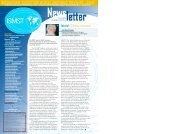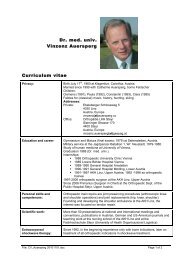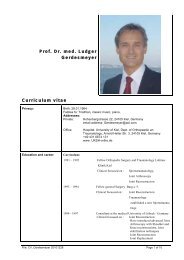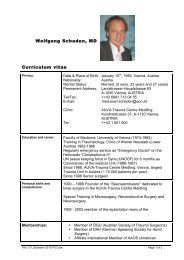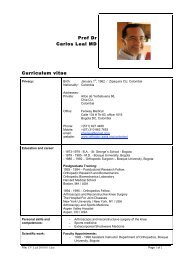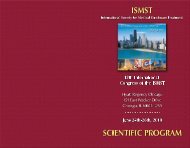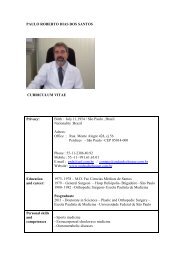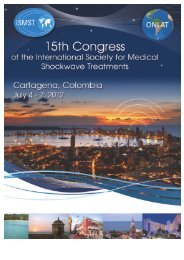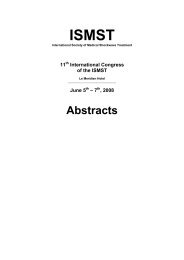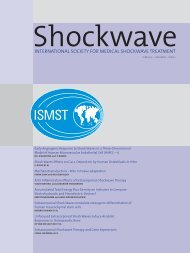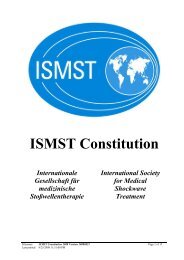Abstracts - ISMST - International Society for Medical Shockwave ...
Abstracts - ISMST - International Society for Medical Shockwave ...
Abstracts - ISMST - International Society for Medical Shockwave ...
You also want an ePaper? Increase the reach of your titles
YUMPU automatically turns print PDFs into web optimized ePapers that Google loves.
<strong>Abstracts</strong><br />
19. New Insights into Morphology of Cardiac Tissue Regeneration<br />
after direct Epicardial Shock Wave Treatment<br />
Johannes Holfeld, Daniel Zimpfer, Can Tepeköylü, Anita Thomas, Patrick Paulus, Seyedhossein Aharinejad,<br />
Wolfgang Schaden, Michael Grimm<br />
Institution:<br />
Department of Cardiac Surgery, Innsbruck <strong>Medical</strong> University<br />
Device and producing company: Cardiogold, CRT AG (produced by MTS Europe GmbH)<br />
Introduction: Recently we observed cardiac regeneration in rats after direct epicardial <strong>Shockwave</strong> Therapy as shown by a<br />
marked increase of left ventricular ejection fraction. However, the underlying mechanism remains largely unknown.<br />
Methods: Sprague Dawley rats were subdivided into 3 groups: sham-operated (sham), infarcted myocardium with direct<br />
epicardial SWT (SWT group) and infarcted myocardium without SWT (control). Four weeks following myocardial infarction<br />
(MI), SWT (100 impulses at 0.38 mJ/m²) was applied directly to the anterior wall in the SWT group. Cardiac function was<br />
evaluated using echocardiography. Angiogenesis was evaluated by analysis of several RNA and protein expressions.<br />
Morphological changes were measured by quantitative morphometry in immunohistochemically stained sections.<br />
Results: Fourteen weeks after SWT, left ventricular ejection fraction (LVEF) improved in the SWT group as compared to 4<br />
weeks after MI (37±8%, p=0.021) and as compared to the controls (21±4%, pDESWT), decreasing to a normal level at 14<br />
weeks after treatment in the anterior wall of treatment groups.<br />
Amount of collagen was decreased in treatment groups, in particular in areas surrounding the infarction scar, whereas<br />
muscle tissue was clearly recovered in these border zones.<br />
Discussion: Improvement of cardiac function in ischemic heart disease highly depends on the recovery of hibernating<br />
myocardium in the infarction border zone. Direct epicardial <strong>Shockwave</strong> Therapy induces tissue regeneration of the border<br />
zone as shown by reduced collagen and an increase of muscle.<br />
Conclusion: Passive movement of the scar tissue by recovered myocardial contractility of border zones converts dyskinetic<br />
into akinetic motion of the anterior wall thereby being the morphological correlate to increased cardiac output.<br />
20. Bone morphogenetic protein-2 expression in spinal fusion masses enhanced<br />
by extracorporeal shock wave treatment: a rabbit experiment<br />
Tao-Chen Lee, Ching-Jen Wang<br />
Institution:<br />
Dept. of Neurosurgery and Dept. of Orthopedic Surgery, Chang Gung Memorial Hospital,<br />
Kaohsiung <strong>Medical</strong> Center, Chang Gung University College of Medicine, Taiwan<br />
Device and producing company: OssaTron, HMT High <strong>Medical</strong> Technologies, GmbH<br />
Introduction: Extracorporeal shock waves (ESW) are introduced to enhance spinal fusion. This study was conducted to<br />
assess the effect of ESW on bone morphogenetic protein-2 (BMP-2) expression in a spinal fusion experiment.<br />
Methods: Twelve rabbits underwent fusion at bilateral L5–6 intertransverse spaces. They were evenly divided into two<br />
groups. In the study group, bilateral L5 and L6 transverse processes were treated with 1,000 pulses of ESW at 14 kV at 12<br />
weeks. In the control group, the rabbits did not receive ESW treatment. All rabbits were sacrificed at 16 weeks, and their<br />
lumbar spines were harvested <strong>for</strong> radiographic and molecular biological study.<br />
Results: In the study group (n=6), the radiographs showed good fusion in all six rabbits, while in the control group (n=6)<br />
good fusion was found only in three rabbits (50%). Although more rabbits in the study group had a good fusion result, the<br />
inter-group difference was not statistically significant (p=0.182). In the molecular biological examination, the mean value of<br />
the normalized expression of BMP-2 mRNA in the fusion masses of the study group was 90±8.4 while that of the control<br />
group was 77.33±6.74. Statistical analysis showed the study group had a significantly higher BMP-2 mRNA expression in<br />
the fusion masses than the control group (p=0.018).<br />
Discussion: There has been evidence that ESW treatment promotes expression of BMP in treated long bones. These<br />
findings inspired us to study whether ESW treatment stimulates expression of BMP in spinal fusion masses. According to<br />
our previous experiment, we found that low energy ESW treatment is effective in enhancing spinal fusion. The major theme<br />
of the current study was to assess the over expression of BMP-2.<br />
Conclusion: The current study showed that ESW treatment enhances BMP-2 mRNA expression in spinal fusion masses.<br />
21



